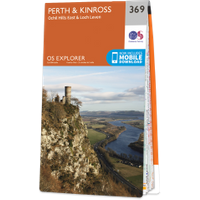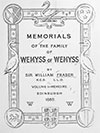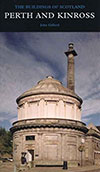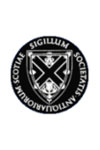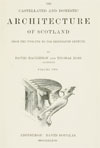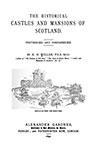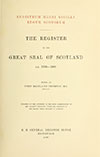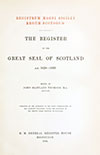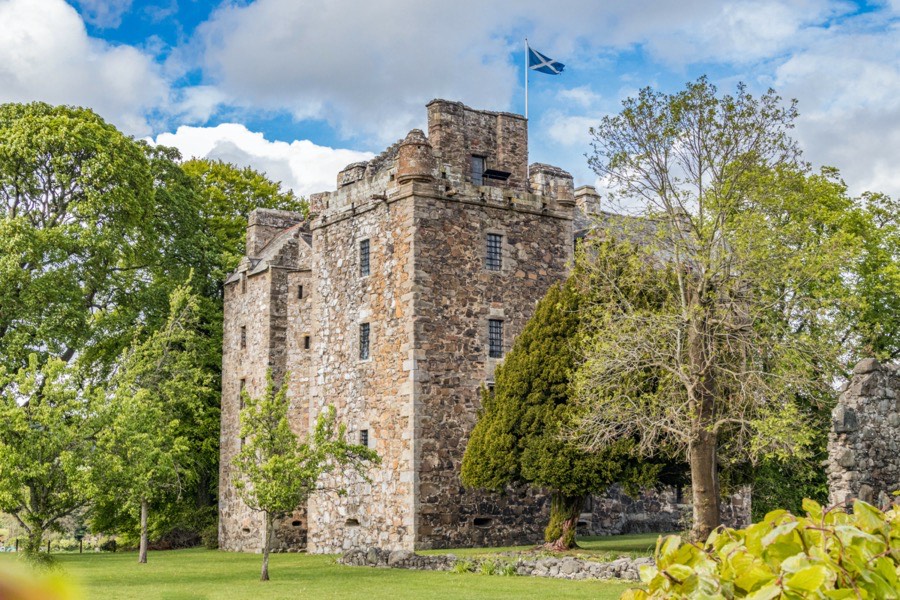

Elcho Castle is a 16th century Z-plan tower house which has been owned by the Wemyss family since it was constructed.
Little seems to be known about Elcho’s early history, although by the 13th century the lord of Elcho was John de Pincerna and there is likely to have been a tower of some sort here by that time. There are legends relating to William Wallace being at Elcho in 1296 with a Wallace’s Well and Wallace’s Yew in the vicinity.
According to Blind Harry, a 15th century author not always known for the veracity of his stories, Wallace resided for a while at Elchoch in a property belonging to his cousin, one William Crawford. Whether this was the castle of Elcho or another property on the lands is not clear.
From an early period Elcho was split into Easter Elcho, where the castle was located, and Wester Elcho, upon which Elcho Priory was founded early in the 13th century. The Priory may have been established by David Lindsay of Glenesk, an ancestor of the Lindsays of Crawford which might account for the Crawford in Blind Harry’s story.
Some sources state that Alexander de Abernethy owned the lands of Elcho during the reign of Robert the Bruce and that his son-in-law, Sir David de Lindsay, founded the Priory however this would be a century later than the actual date of its foundation. Interestingly Alexander was a great-grandson of Gillemichael, Earl of Fife, whose daughter is thought to have married Michael Wemyss of Wemyss and Methil.
In June 1304 John de Pincerna, the son of John de Pincerna, exchanged the barony of Elcho with Sir John de Inchemartyn for land in Pitmiddle. Sir John is thought to have died in 1306 and was succeeded by his son, Sir Henry, who in turn was succeeded by his brother, Sir John. This Sir John married Margaret Wemyss of Wemyss and their daughter, Isabel, inherited her father’s estates.
Isabel married Sir Alan Erskine and they had two daughters, Margaret, who married Sir John Glen, and Isabella or Isabel, who married Sir John Wemyss, who both inherited half of the estates each. Margaret and Sir John Glen had three daughters, Isabel, Marjorie and Christian, who all married Ogilvys, which led to Margaret’s share of Elcho being split into three sixth parts. Isabella and Sir John Wemyss had two sons and four daughters but Isabella’s share of Elcho seems to also have been split into three sixths.
Christian Glen married David Ogilvy and had a son, Alexander Ogilvy of Kinneff, and three daughters, Margaret, who married Silvester Rattray of Rattray, Marjorie, who married Walter Tulloch of Tulloch, and Christian, who married a Lindsay.
It is certainly thought that a castle was in existence by the early 15th century, on the sixth part of Elcho owned by Sir David Wemyss of Wemyss, the eldest son of Isabella and Sir John Wemyss. In July 1427 Sir David exchanged his part of Inchmartine with his aunt Margaret’s part of the manor of Wemyss, and there were other transactions between the branches of the family in an attempt to better consolidate their estates.
In 1429 Sir David and Hugh Fraser of Lovat agreed a compact or treaty at Elthok, with Fraser issuing an acquittance or receipt for a settled debt to his “derreste and beste beluffit bruthir in lauch, Davy of the Wemys” for thirty-five merks of tocher. Fraser had married, as his second wife, Sir David’s sister, Isabel or Isabella.
Sir David had married Christian, daughter of Alexander Lindsay, 2nd Earl of Crawford, and upon Sir David’s death before September 1430 he was succeeded by their infant son, John. Sir John later married Margaret de Levingstoune, daughter of Robert de Levingstoune de Drumry.
Robert was a half-brother to Isabel de Inchmartin, their mother being Margaret Wemyss of Wemyss who after Sir John de Inchmartine had married John de Levingstoune de Drumry.
In July 1468 Sir John de Wemis, resigned the sixth part of the lands of Elchok and his wife, Margaret, resigned the half lands of Elchok and they were granted by James III to their son, also John de Wemis.
In August of the same year Sir John granted his half of the lands of Inchmertin to Sir David de Ogilvy in exchange for various lands including a sixth part of the lands of Elchok which included the principal messuage. Sir John’s great-grandfather, also Sir John de Wemyss, had married as his third wife Christian de Ogilvy, a relative of Sir David.
It may have been around this time that a square tower, the south-west corner tower of the current castle, was built. The tower rises to a height of four storeys plus a garret within a parapet walk, at each corner of which was a round turret with an unusual stone roof. It features thicker walls than the rest of the castle which likely indicates an earlier origin, and it may originally have been a freestanding tower erected upon a slightly elevated rocky knoll on ground rising from the River Tay below.
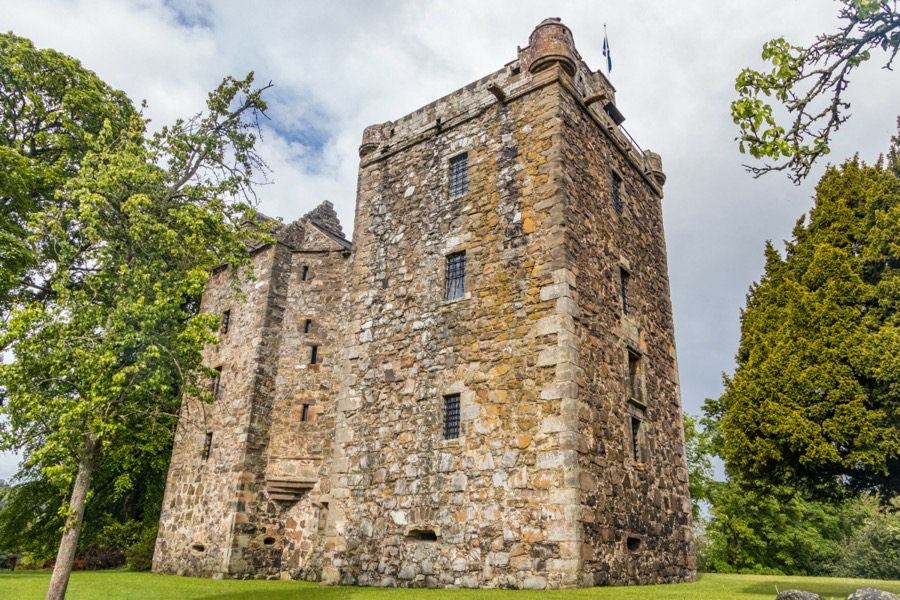
Immediately to the north of the castle are rocky cliffs, likely partially created artificially by quarrying away rock for the castle’s construction. The whin rubble is local but the sandstone dressings would have been transported from another area.
In February 1483 or 1484 Alexander Cunyngham de Polmas was confirmed in various lands including the sixth part of the lands of Elchquhok. Alexander was a son of Isobel Glen who had married secondly Robert Cunningham of Auchinbowie.
In October 1487 Dorothy Tulloch de Ardargy, a daughter of Marjorie Ogilvy and Walter Tulloch of Tulloch, sold, with the consent of her husband, Walter Wod, to James Oliphant de Ardquhalze various lands including her eighteenth part of Estir-Elyok with its mill. These lands were in July 1500 granted to Oliphant’s brother, Walter Oliphant.
The next stage of development is likely to have been the addition of a long hall block which extends to the east from the north side of the square tower and measures around 18.0m long by around 8.8m wide. The south wall of this block, along with both east and west gable ends, are also of a thicker construction than most of the rest of the castle again pointing to an older period of development. The slightly splayed east gable also suggests that it may have been remodelled at some point. The block was positioned in such a way that the south-west tower was able to defensively cover the west and south sides of it.

Sir John was dead by early 1508 and in that year Sir William Scott of Balwearie sold his one-eighteenth part of West Wemyss, perhaps also including an eighteenth part of Elcho, to Sir John’s son, Sir David Wemyss of Wemyss.
In June 1511 Sir David acquired more of the Elcho lands when he paid ten merks for the sixth part of the lands of Wemyss, Elcho and Balhabram to Robert Cunynghame de Polmais-Cunynghame, the son and heir of Sir Alexander Cunningham of Polmaise. In the same year he bought another eighteenth part of the barony of Elcho from Walter Oliphant of Archellie, presumably the brother of James Oliphant de Ardquhalze and the lands he bought from Dorothy Tulloch.
Alexander Lindsay, a great-grandson of Christian Glen, sold various lands to James Bissat de Ester-Kynneff in November 1516 including his eighteenth part of Elquhoche.
In 1522 Andrew Rattray of Westhall, probably a grandson of Margaret Ogilvy and Silvester Rattray of Rattray, sold his one-eighteenth part of West Wemyss to Sir William Scott of Balwearie and this likely also included his one-eighteenth part of Elcho.
David Wemys de Wemys received a charter of various lands in June 150, including the lands of Elchok, which were all incorporated into the free barony of Wemys for him by James IV.
In June 1541 David Wod de Crag, the second son of Dorothy Tulloch, received confirmation of various lands which James Bisset de Estir Kynneff had resigned including an eighteenth part of Elquhoch. Wod sold various lands, including his eighteenth part of the lands of Elcho, to John Wemys of Wemys in May 1546.
In December 1548 Elcho Priory was attacked and burnt by the English garrison of Broughty Castle. It seems unlikely that Elcho Castle would be left unscathed at that time. Following the attack Sir John offered financial assistance to the nuns over the following years, however the nuns had ran up debts of 400 merks by 1558. Unable to repay Sir John they instead feued to him the Cottarland of Wester Elcho, the Mains of Elcho and the Grange of Elcho in August, September and October of that year.
Around this time Sir John is thought to have begun significantly remodelling the castle at Easter Elcho or Wemyss Elcho as it was also known. This is likely to have entailed significant changes to the main block and the construction of several towers on the north side of it, and represents a transition in Scottish building style from defensive castles to more luxurious mansions.
There are some 17 gunloops at ground level around the castle, an unusually high amount that may partly be explained by the need for defence for a prominent family but also partly to act as a status symbol.
The entrance to the castle is on the east wall of the stair tower in the re-entrant angle with the main block. It was protected by an unusual angular machicolation on the battlements effected by a stone around 1.8m long lying across the re-entrant angle forming a triangular hole high above the door. The door was also protected by gunloops on both the tower and main block.
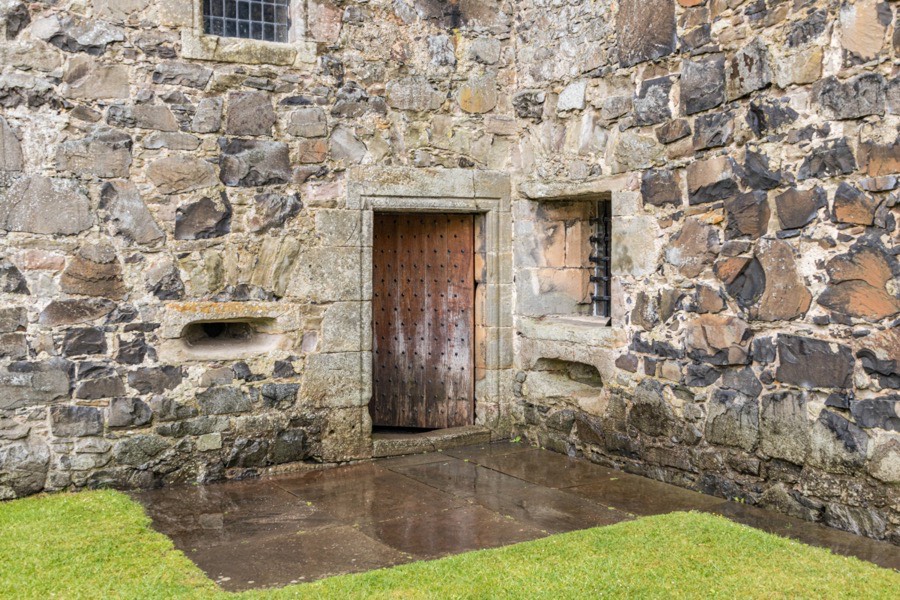
The doorway, which was also protected by a yett, leads into a tunnel-vaulted lobby. Straight ahead is an entrance into two inter-linked small vaulted chambers which were latterly used as guardrooms but may originally have represented dungeons within the basement of the original tower. To the right is a doorway into the main block and to the left is a wide staircase. It may have been at this time that the south-west tower was partially-converted into a stair tower, allowing for a generous spiral staircase which rises from the ground floor to the first.

Passing through the thickness of the main block’s wall leads into a passageway running from west to east and giving access to three ground floor chambers. At the west end of the block is a vaulted kitchen with large fireplace, off which is a further vaulted chamber in the north-west square tower. It is likely that this tower was added to the corner of the main block at a later date although its strange angle may hint at its antiquity.
To the east of the kitchen is a vaulted storeroom off the north side of which is access to a spiral staircase housed within a round tower on the north side of the main block, again likely to be a later addition. This staircase is the only one in the castle which serves all of the floors. The tower is provided with a pair of gunloops pointing east and west.
The easternmost vaulted storeroom takes up the full width of the block and gives access to a chamber in the round north-east corner tower which features a further three gunloops for defence. Also off the main storeroom is a second entrance into the aforementioned spiral staircase on the north side.
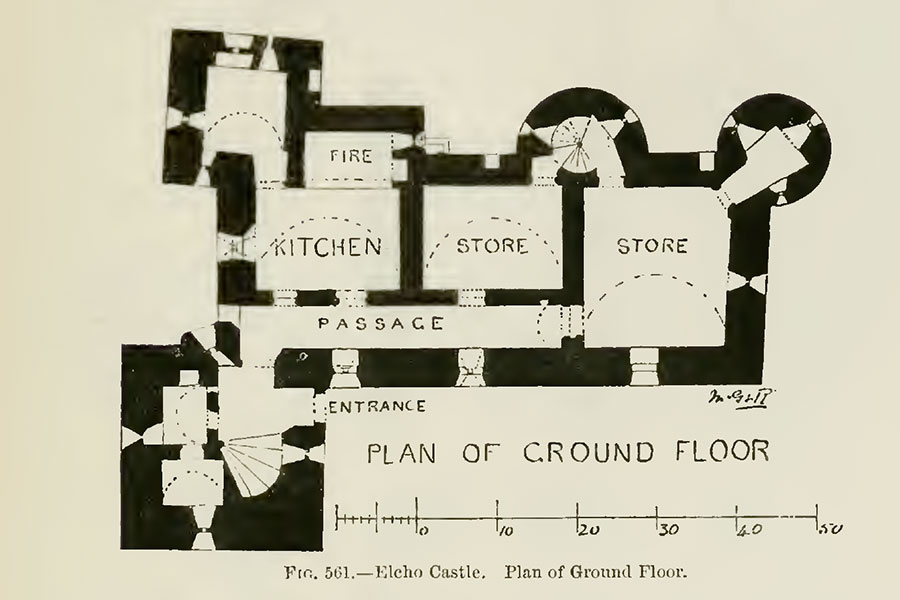
David MacGibbon and Thomas Ross, Edinburgh, 1887
Returning back along the passageway, into the stair tower and up the grand spiral staircase leads to the Great Hall. Passing between the stair tower and the Great Hall an opening on the left gives access to a smaller spiral staircase corbelled out between the two wings which leads up to the other floors in the stair tower.
The Great Hall occupies most of the first floor and is dominated by a wide fireplace in the centre of the south wall, flanked by deep window openings.
Off the north-west of the Great Hall is a vaulted private chamber within the smaller square corner tower. Beside the entrance to this chamber is another doorway into a second corbelled-out spiral staircase which leads up to a chamber above in the corner tower. There is no access to the main block at second floor level perhaps suggesting that the corner wing was reserved for the laird as a private suite of accommodation.
To the east of the Great Hall is a withdrawing room from which is gained access to a small chamber in the north-east round tower. Beside the entrance to the withdrawing room is a door leading into the spiral staircase within the north wall’s round tower.

David MacGibbon and Thomas Ross, Edinburgh, 1887
This staircase leads up to the second floor where it gives access to an easternmost bedroom, off which is a smaller chamber in the north-east tower, and a bedroom at the centre of the hall block, either side of a stone wall. The westernmost bedroom on this level would only have been accessible via the spiral staircase between the main block and the south-west tower. As mentioned above the spiral staircase serving the north-west tower bypasses this level in the main block but provides access to a further bedroom chamber. Each of the second floor’s chambers has its own garderobe within the thickness of the castle’s walls and its own fireplace.

David MacGibbon and Thomas Ross, Edinburgh, 1887
All three of these smaller spiral staircases give access to the third floor, which was separated from the second floor by a wooden floor of which only the beams remain.
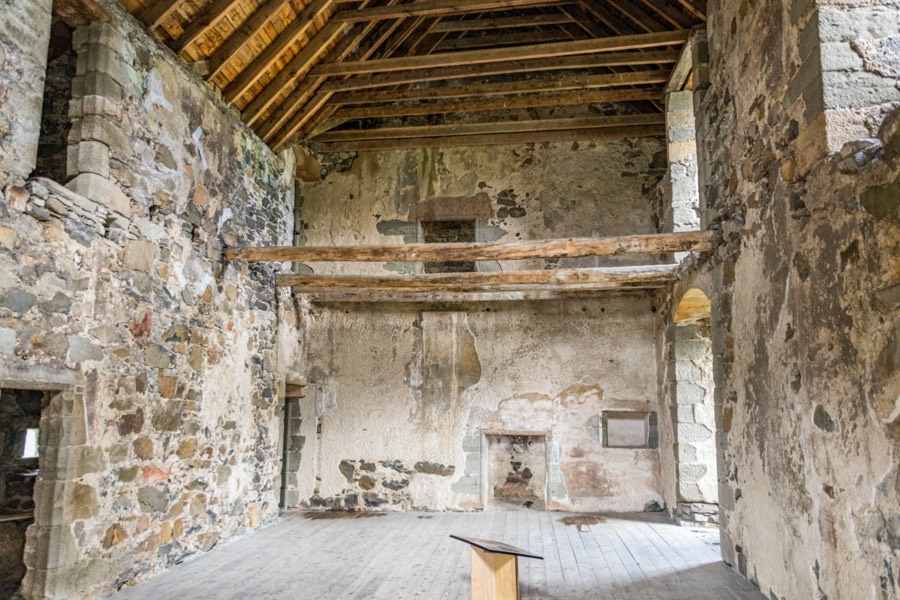
The north-west one opens into both a chamber in the north-west tower and one at the west of the main block, and the one at the south-west similarly opens into the same main block chamber while also providing access to a chamber in the south-west corner tower. The spiral staircase in the round north tower provides access either side of a stone wall, as on the second floor, to chambers at the centre and east end of the main block. Off the north-eastern corner of the eastern chamber is a square room at the top of the round corner tower while off the south-eastern corner is a round room within a bartizan. As on the second floor each chamber at this level is furnished with its own garderobe and fireplace.

David MacGibbon and Thomas Ross, Edinburgh, 1887
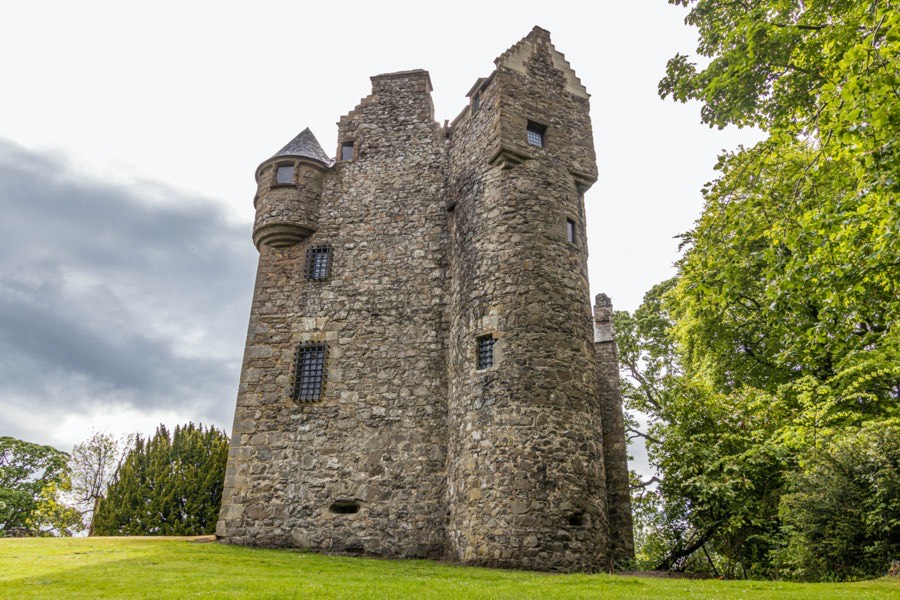
A straight stair leads off the spiral staircase in the north round tower to provide access to an open passage leading to a room at the top of the north-east corner tower and also to a square room at the top of the round spiral stair tower.

David MacGibbon and Thomas Ross, Edinburgh, 1887
The aforementioned round bartizan at the south-east corner features three dummy windows and a shot hole. To its west above the window of a dormer on the south side of the main block is a carved stone annulet which usually denotes a fifth son. It is thought that this could refer to Captain Michael Wemyss who served under the Earl of Morton. However it should be noted that Captain Wemyss was an adult by the time the castle is said to have been built, suggesting that either the castle was built perhaps a couple of decades earlier than assumed, which is entirely possible, or that the carving relates to someone else.
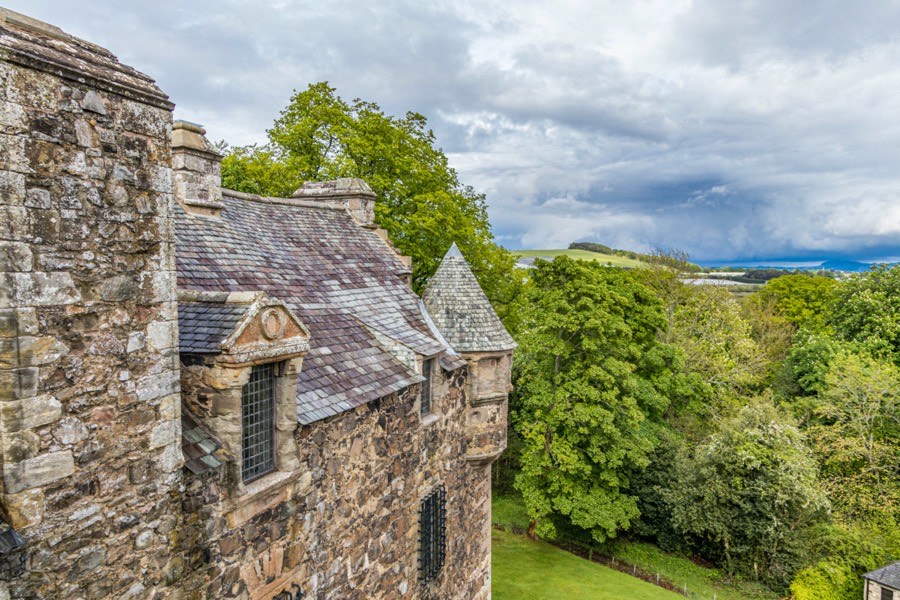
The castle is thought to have had a barmkin projecting south from it, the castle itself forming the northern side of it. Only part of the south wall remains and consists of a round corner tower, housing an oven at ground floor level with two small apartments above, an adjoining section of wall stretching westwards and the footings of the west wall returning north. Remaining corner corbelling suggests that the round tower originally had a square caphouse.

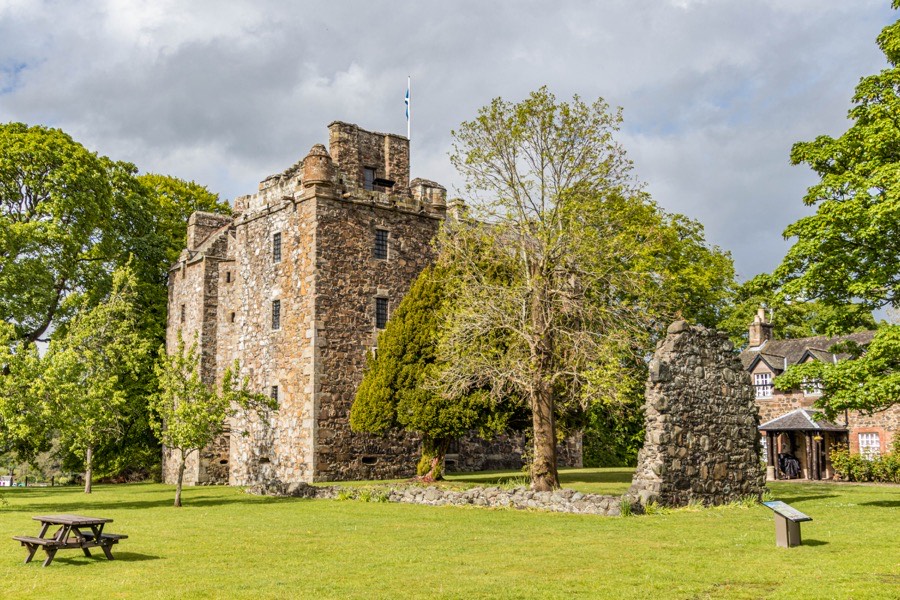
It has been suggested that a narrow channel leading south-west from the River Tay towards the castle was originally built to fill a moat around the castle’s courtyard walls however there is seemingly no evidence of this and the channel may be of a relatively modern construction. If it was contemporary with the castle then it’s also possible that it was built as a canal to carry goods up to the castle from the river, a distance of around 100m. The quarry below the castle may originally have been flooded.
Around 120m to the south-west of the castle is a 16th century beehive doocot.
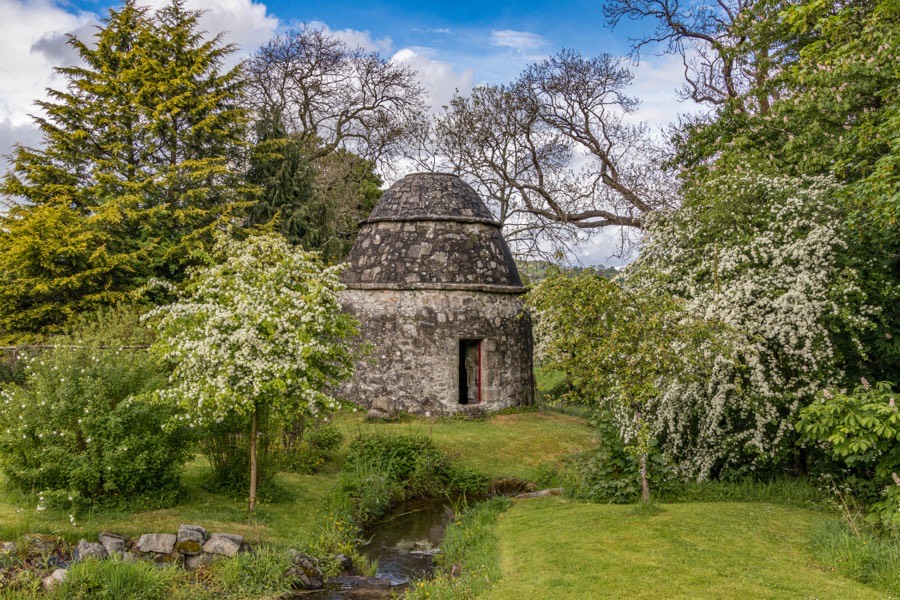
In 1570 Sir John owed the late Thomas Bryson or Boynting £7 for ironwork, thought to have been the yett and window grilles, and this may mark the end of this period of construction. The grilles are of a “cage” or “basket” style, projecting outwards from the walls and offered protection from intruders and for the expensive glazing.
Sir John died in 1572 and was succeeded by his eldest son by Margaret Otterburn, Sir David. Sir David married Cecilia Ruthven, daughter of William Ruthven, 2nd Lord Ruthven. In May 1589 he resigned all of his lands, including the lands of Elchok with the castle, manor and lie Maynis de Elchok, into the hands of James VI for them to be regranted to his son and heir, John, reserving them in liferent for himself and his wife.
Upon Sir John’s death in 1597 his son, John succeeded to his estates although he had already been in possession of them for some years. He had married in 1574 Margaret Douglas, daughter of William Douglas of Lochleven, later 6th Earl of Morton. She died without issue however and Sir John married secondly Mary or Maria Stewart, daughter of Sir James Stewart of Doune, in 1581.
In June 1605 Sir John resigned all of his lands, including the lands of Elchok, into the hands of James VI and they were regranted to his eldest son, David, who in 1608 married Elizabeth Leslie, daughter of Andrew Leslie, 5th Earl of Rothes. David died in August 1608 however, and his younger brother, John, was retoured as heir to their father.
Sir John was dead by June 1622 and was succeeded by the younger John who around 1609 had married Jean Gray, daughter of Patrick Gray, 6th Lord Gray. He was knighted by June 1618, created a Baronet of Nova Scotia in 1625 and made a lord of Parliament as Lord Wemyss of Elcho in April 1628. In 1631 Lord Wemyss resigned the family estates in favour of his eldest son, David, Master of Wemyss, and David’s wife, Anna Balfour, eldest daughter of Robert Balfour, 2nd Lord Balfour of Burleigh.
Lord Wemyss was involved in the coronation of Charles I on the 18th of June 1633 and on the 25th of June he was created Earl of Wemyss and Lord Elcho and Methil. To his elevation in status a plaster cornice, decorated with a diagonal chevron rib winding its way between thistles of Scotland, fleur-de-lis of France and roses of England, was installed in the Great Hall and neighbouring chamber.
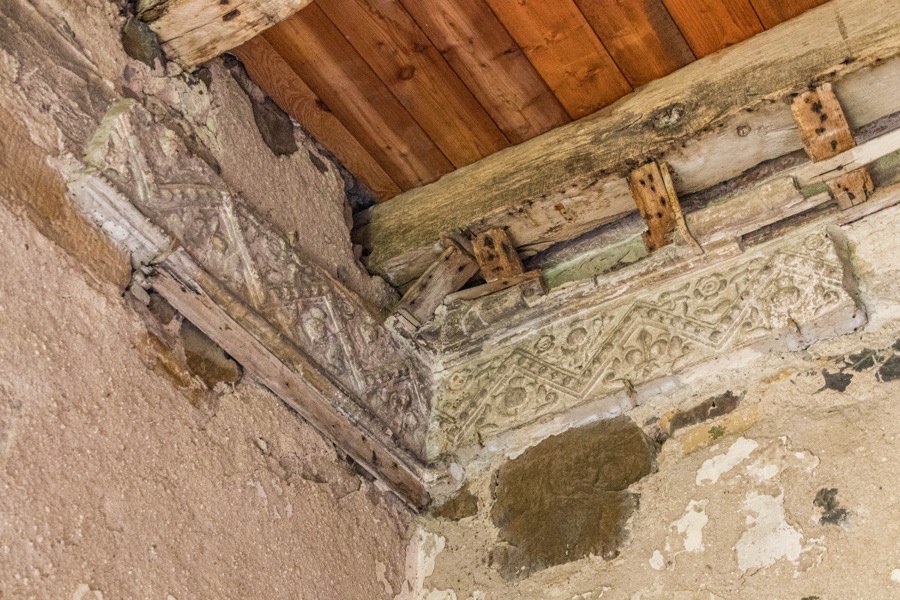
A stone carved with the initials E.I.W., for Earl John Wemyss, is built into the gable of the courtyard wall which suggests a date after 1633, although the stone may have been inserted into an earlier structure.
The 1st Earl died at Wemyss in November 1649 and was succeeded by his only son, David, Lord Elcho, who had been active with the Covenanters and led their army to defeat at the Battle of Tibbermuir in 1644.
As 2nd Earl of Wemyss he married two further times, to Helenor Fleming, eldest daughter of John Fleming, 2nd Earl of Wigtown, in 1650 and in 1653 to Margaret Leslie, second daughter of John Leslie, 6th Earl of Rothes. His third union produced a daughter, Margaret, who was the last child of sixteen and one of only two to outlive their father.
The 2nd Earl carried out significant improvements at his Wemyss estates, developing coal mines, salt pans and remodelling the castle, however Elcho seems to have been treated very much as a secondary property.
In March 1672 Margaret Wemyss married her cousin, Sir James Wemyss of Caskieberry, later Lord Burntisland. The 2nd Earl resigned all of his estates and titles to them but reserved them in liferent to himself, except for Elcho and Lochgelly which were granted to Margaret and Sir James for maintenance. In July 1679 he died at Wemyss and his daughter succeeded him as Margaret Wemyss, 3rd Countess of Wemyss.
Upon Margaret’s death in March 1705 her son, David, succeeded as 4th Earl and the following year was appointed Lord High Admiral of Scotland. He had married firstly Anne Douglas, only daughter of William Douglas, 1st Duke of Queensberry. Their eldest son, David, Lord Elcho, died in December 1715 and so their second son, James, became heir and Lord Elcho, succeeding upon his father’s death in March 1720.
In September of that year the 5th Earl married Janet Charteris, daughter and heiress of Colonel Francis Charteris of Amisfield. Their eldest son, David, Lord Elcho, was heir to the Wemyss estates and so in 1729 Colonel Charteris made a disposition of his property in favour of their second son, Francis. Colonel Charteris died in 1730.
In 1742 the 5th Earl infefted David, Lord Elcho, in his estates however Lord Elcho fought on the Jacobite side at the Battle of Culloden in 1746, later escaping to France, and was attainted as a result.

Francis, who had assumed his maternal grandfather’s name to become Francis Wemyss Charteris, made a claim for his elder brother’s estate in 1749, a claim which was opposed by their father. The claim was dismissed by the Lords of Session and the House of Lords however an agreement was reached with the Barons of Exchequer whereby Francis paid £8500 sterling for the estate.
In July 1750 the 5th Earl executed a procuratory of resignation of his estates in favour of himself and his third son, James, with the caveat that if Lord Elcho died before the Earl then the estates would instead pass to Francis. The 5th Earl died in March 1756 while Lord Elcho was still alive and so James inherited the Wemyss estates in May 1756. The earldom was forfeited but claimed by Lord Elcho as 6th Earl of Wemyss.
James Wemyss of Wemyss served in the Royal Navy and married in August 1757 his cousin, Elizabeth Sutherland, only daughter of William Sutherland, 16th Earl of Sutherland. During his ownership of the estates, with the focus still very much on Wemyss, Elcho Castle was used as a farmhouse and to store grain.
In 1772 there was a shortage of corn in Scotland as a result of a bad harvest, however some farmers continued to export grain to England and France and the tenant farmer at Elcho, John Donaldson, was apparently notorious for this practice. In January 1773 a mob marched to Elcho Castle to destroy the grain stored there however soldiers had been placed in charge of it and the mob dispersed when they were assured that the grain would be sent to market at Perth.
James Wemyss died in May 1786 and Lord Elcho in April 1787 in Paris, and while it was General William Wemyss of Wemyss who inherited the Wemyss estates Francis Wemyss Charteris claimed the forfeited title of 7th Earl of Wemyss and Elcho went to him. Francis had, in 1784, acquired the Gosford estate, and also built himself a house in Edinburgh meaning that Elcho was neglected.
He had married Katherine or Catherine Gordon, daughter of General Alexander Gordon, 2nd Duke of Gordon, in September 1745. He died in August 1808 but had been predeceased by their only son, also Francis Wemyss Charteris, Lord Elcho, in January of the same year. Lord Elcho had married in 1771 Susan Keck, a daughter of Anthony Keck and a granddaughter of James Hamilton, 4th Duke of Hamilton, and it was their eldest and only son, another Francis Wemyss Charteris, who succeeded as Lord Elcho.
Upon the death without male issue of his second cousin twice removed, William Douglas, 4th Duke of Queensberry and 3rd Earl of March, Lord Elcho succeeded to the Earldom of March and assumed the additional surname of Douglas. In 1821 Francis Wemyss Charteris Douglas, 4th Earl of March, was created Baron Wemyss of Wemyss and in 1826 he obtained a reversal of the attainder of the Earldom of Wemyss and became 8th Earl of Wemyss.
In 1830 the 8th Earl of Wemyss re-roofed and re-glazed the Elcho Castle to protect it for the future and halt its decline. Following his death in June 1853 he was succeeded by his eldest son with Margaret Campbell, Francis Wemyss-Charteris, as 9th Earl of Wemyss. The 9th Earl married Louisa Bingham, a daughter of Richard Bingham, 2nd Earl of Lucan, and they lived in Edinburgh. He died in January 1883 and was succeeded by their eldest son, Francis Richard Charteris, as 10th Earl of Wemyss.
The 10th Earl was married to Anne Frederica Anson, second daughter of Thomas Anson, 1st Earl of Lichfield, and they lived at his parents’ house in Edinburgh. Their first three sons predeceased their father and so upon his death in 1914 the estates and title passed to their fourth son, Hugo Richard Charteris, who became the 11th Earl of Wemyss and 7th Earl of March.
In 1929 the 11th Earl placed Elcho Castle into state care, although the Wemyss family retained ownership. The title of Lord Elcho is still used as a title for the heir to the Earldom of Wemyss. Conservation work took place on the roof in 1931 and new windows were installed.
The area around the south-east corner tower of the courtyard was excavated in 1987 ahead of consolidation. The original floor level was uncovered around 0.8m below the current floor and consisted of burnt clay with flagstones adjacent to the oven. The oven was found to be 2.1m in diameter by 1.5m in height and was elevated from the original floor level by 0.7m.
Elcho Castle is now operated as a visitor attraction by Historic Scotland.
Alternative names for Elcho Castle
Easter Elcho; Eister Elcho; Elchiok; Elchoch; Elchok; Elchoth; Elchow Easter; Elchquhok; Elchyok; Elgok; Elkho; Elkok; Elquho; Elquhoch; Elquhoche; Elthok; Elyock; Estir-Elyok; Place of Elchok; Wemis-Elcho; Wemyss-Elcho; Wemyss Elcho


